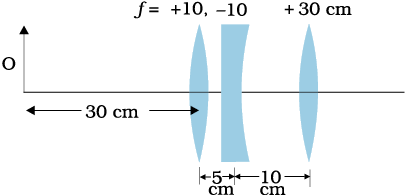If \(f=0.5\) m for a glass lens, what is the power of the lens?
1. \(+0.4\) D
2. \(+4.0\) D
3. \(+0.2\) D
4. \(+2.0\) D
The radii of curvature of the faces of a double convex lens are \(10\) cm and \(15\) cm. Its focal length is \(12\) cm. What is the refractive index of glass?
1. \(1.3\)
2. \(1.2\)
3. \(1.5\)
4. \(1.4\)
A convex lens has a \(20~\text{cm}\) focal length in air. What is the focal length in water? (Refractive index of air-water = \(1.33\), refractive index for air-glass = \(1.5\))
1. \(+72.72~\text{cm}\)
2. \(+78.2~\text{cm}\)
3. \(-72.72~\text{cm}\)
4. \(+70.2~\text{cm}\)
Find the position of the image formed by the lens combination in the given figure.

| 1. | Final image is formed 30 cm to the right of the third lens. |
| 2. | Final image is formed 20 cm to the left of the third lens. |
| 3. | Final image is formed 30 cm to the left of the third lens. |
| 4. | Final image is formed 20 cm to the right of the third lens. |
What focal length should the reading spectacles have for a person for whom the least distance of distinct vision is \(50~\text{cm}\)?
1. \(-50~\text{cm}\)
2. \(+50~\text{cm}\)
3. \(-60~\text{cm}\)
4. \(+60~\text{cm}\)


